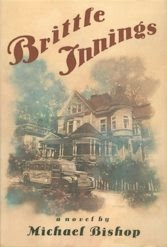 While most people respond to a tragedy like Virginia Tech with shock and sadness, a contemptible few immediately react by claiming the event as strained support for their pet political theories. Two particularly shameful examples from the past week are pertinent to the science fiction, fantasy, and horror genre community. They come from opposite sides of the political spectrum, but should be offensive to all rational readers regardless of their politics.
While most people respond to a tragedy like Virginia Tech with shock and sadness, a contemptible few immediately react by claiming the event as strained support for their pet political theories. Two particularly shameful examples from the past week are pertinent to the science fiction, fantasy, and horror genre community. They come from opposite sides of the political spectrum, but should be offensive to all rational readers regardless of their politics.The first is a long letter to Locus Online posted there on April 21. It is a bizarre, paranoid rant by Marleen Barr, who once taught at Virginia Tech and fancies herself a pre-eminent feminist science fiction critic. In Barr’s view, Cho Seung-Hui’s killing spree was a misguided but understandable reaction to the intolerable lack of diversity at Virginia Tech and the infuriating existence of George W. Bush.
Barr explains that Cho selected his first victim to make a statement about sexism at Virginia Tech: “I think that Cho Seung-Hui picked a female to be his first victim in order to make a statement about how Tech responds to that which is Other in relation to white male patriarchy. He knew that one shot dead female would be treated as, well, ‘just’ one shot dead female. No need to shut down the campus.” (Never mind that the other dorm victim, Ryan Clark, was male.) Cho then purposefully targeted only minority faculty for his shooting spree, as a peculiar form of backlash against the lack of diversity on campus. (To make this theory fly, Barr ignores Kevin Granata and assigns Jamie Bishop to an unorthodox minority: German teachers with long hair.) All the white students Cho shot simply “were in the wrong place at the wrong time.”
How the President is responsible for all this is unclear, but Barr feels the need to mention Bush and members of his administration by name a dozen times in her letter – all the while using the annoying rhetorical tactic of denying she is saying what she is saying even as she says it: “I will presently refrain from comparing the Cho Seung-Hui gun-in-hands hyper-masculine action hero image to that of the theatrical spectacle of Bush on the aircraft carrier.” (In the words of Inigo Montoya, that word “refrain,” I do not think it means what you think it means.) Barr’s best moment is where she points out that Bush once served turkey to soldiers in Iraq and a Hokie, the Virginia Tech mascot, is a castrated turkey. Her point is entirely obscure, but hell, it sounds anti-Bush, so that’s all good.
Barr’s theories are not just nutty, they are vicarious terrorism. She seizes on an atrocity that someone else has committed and assigns blame to whatever it is about society that she dislikes. It is every bit as wrong-headed and offensive as when Jerry Falwell blamed 9/11 on feminists and gays.
The second comes from Mary Grabar, a conservative columnist at Townhall.com, who teaches English at someplace called Clayton State University. In an April 24 column titled “The making of a mass murderer--In english class,” Grabar attributes Cho’s murderous rampage to the fact that he took a class in horror literature and film at Virginia Tech. She wonders whether this directly caused the massacre, implying that Cho learned how to commit murder by watching The Texas Chainsaw Massacre in class (if only he had – he would have killed fewer people using a chainsaw). Even if not, she asserts that this class reflects an educational system that wastes time on unworthy topics and weakens students by undermining their moral resolve and religious beliefs, with the natural end result of an “egotistical, narcissistic, soulless, anti-Christian, anti-authority, anti-hero” like Cho Seung-Hui.
Poking around on the Internet, I managed to find the course description for this class in Contemporary Horror (scroll down to English 3984). Alongside The Texas Chainsaw Massacre and Stephen King, the course covers Horace Walpole, Edgar Allan Poe, H.P. Lovecraft, and Joyce Carol Oates, all of whom Grabar dismisses as “titillating ephemera” beneath the dignity of a legitimate English course. The course description does not explicitly indicate that Professor Stevens would take course time to “scoff at the notion of original sin,” but Grabar is quite confident he did.
How sad it is that someone who teaches college-level English cannot imagine how the tools of literary analysis might apply to anything more recent than Shakespeare and Chaucer – although the Virginia Tech course guide also lists classes on Shakespeare and Chaucer. (I’ll “refrain” from mentioning the hypocrisy that Grabar teaches Poe in her own American literature class or that she wrote her PhD dissertation about some hokey modern sci-fi writer named Pynchon.)
Ironically, Grabar describes great literature as that which “engages us in moral questions.” But there is no contemporary branch of literature as closely concerned with raising moral questions and confronting evil than horror fiction. One could not get far into many of the books covered in the Virginia Tech course, such as The Female of the Species by Joyce Carol Oates or the graphic novel From Hell by Alan Moore, without considering serious and important moral issues. It is a shame that Cho did not learn from the moral issues in these authors’ works, but then neither has Mary Grabar, so if you see her coming toward you, best dive for cover.




